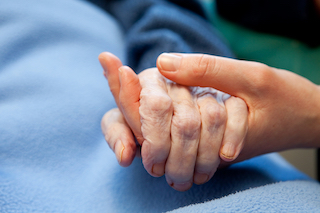 A new systemic review and multivariate meta-analysis published in the Journal of Nature Human Behaviour looked at the physical and mental health benefits of touch interventions.
A new systemic review and multivariate meta-analysis published in the Journal of Nature Human Behaviour looked at the physical and mental health benefits of touch interventions.
“Our study is a meta-analysis, meaning that we collected data from all available studies and merged it together, on the effects of touch interventions on health benefits,” study author Julian Packheiser told us. "Our aim was to find out if touch is suitable to improve physical and mental well-being in general. Since that is however well-known, we wanted to dig deeper. We wanted to find out if what factors influence the efficacy of a touch intervention. Does it work in all demographics (age groups, sexes, clinical vs healthy invidiuals)? Is the duration or frequency important, can human touch even be substituted by other agents?”
Since the study was not directly experimental, the researchers did not have strong hypotheses in the beginning. Instead, they did a synthesis of what is available and worked with whatever they found based on the present literature. The study is not very theory heavy. It is however extremely robust and reliable since the researchers accumulated results from over 130 studies and 10000 participants as a whole.
“My research focus has been on touch research in the recent past and when I looked at the literature, I felt that many individual studies have been done but they lacked coherence and were small in size,” Packheiser told us. “Thus, many puzzle pieces were collected but the big picture was missing. So we decided to synthesize everything that we found to provide answers to the questions if and when touch interventions are advisable both in a professional and private setting.”
The researchers used modern statistical tools to make sense of all previously obtained results. This way, they could analyze the data from all previous studies and get a large overview that has a lot of substance to it.
The analysis revealed many different findings.
“First and foremost, touch interventions are good for you both for physical and mental well-being,” Packheiser told us. “We found the strongest effects for reducing pain, anxiety and depression and the smallest effects in reducing blood pressure or heart rate (but still significant).”
Researchers also found that the duration of the touch was less important, but being touched more often improved health further. In newborns in particular, parental touch was especially beneficial for health. Touch to the head had the strongest effects on well-being compared to other body parts. For touch applied by social robots, the researchers actually found similar health benefits compared to human touch but mental health benefits were less strong when touch was applied by robots or objects such as a body pillow. Furthermore, they found that clinical cohorts profited more strongly compared to healthy cohorts with respect to their health.
“The robot result was extremely surprising to us,” Packheiser told us. “We did not expect that robot or object touch could be partly on par with human touch. But this is actually great news as it opens prospects for these interventions in the future in individuals that do not have a lot of access to touch. For example lonely individuals or people that have been institutionalized might profit a lot from this intervention type.”
Another surprise to the researchers was that familiarity only mattered in newborns. Adults however had similar effects independent of whether touch was applied by a health care professional or someone they know (like the partner). Thus, familiarity seems to be less critical for adults as long as touch is wanted and consented to.
“The field is still young and our study only provides a descriptive overview,” Packheiser told us. “We now need to understand the mechanisms why certain types of interventions work in some individuals but not others to optimize health care treatment for the individual. Future studies should in particular target robot/object interventions to really see if they can be used more on a widespread basis potentially.”
Patricia Tomasi is a mom, maternal mental health advocate, journalist, and speaker. She writes regularly for the Huffington Post Canada, focusing primarily on maternal mental health after suffering from severe postpartum anxiety twice. You can find her Huffington Post biography here. Patricia is also a Patient Expert Advisor for the North American-based, Maternal Mental Health Research Collective and is the founder of the online peer support group - Facebook Postpartum Depression & Anxiety Support Group - with over 1500 members worldwide. Blog: www.patriciatomasiblog.wordpress.com
Email: tomasi.patricia@gmail.com